Did cosmonaut Andrian
Nikolayev
speak on shortwaves during the flight of Soyuz-3?
An
old recording
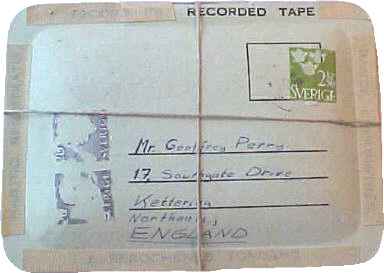 While
visiting Kettering in the beginning of June 2002 Derek Slater, a
colleague
of Geoff
Perry's at The Kettering Grammar School and the radio expert of the
school's satellite tracking group, gave me a little tape reel that
I sent to Geoff Perry in 1968. From the postmark of the little box it
seemed
that it was mailed (see picture on the right) in November 1968.
While
visiting Kettering in the beginning of June 2002 Derek Slater, a
colleague
of Geoff
Perry's at The Kettering Grammar School and the radio expert of the
school's satellite tracking group, gave me a little tape reel that
I sent to Geoff Perry in 1968. From the postmark of the little box it
seemed
that it was mailed (see picture on the right) in November 1968.
When
playing
it back on I indeed found that it contained a report
from me to Geoff Perry about Soyuz-3. Despite its age (34 years
old)
its sound quality is OK. There are two good recordings on the tape of
shortwave
telemetry from Soyuz-3 on 20.008 MHz. There are also some strange voice
signals with someone shouting "Zemlya
ya Sokol" on at least two occasions early on 27 October 1968
(calm
call at 0525 UT and excited call at 0625 UT). Clearly these voice
signals
were not directly from Soyuz-3, because the call sign of Georgi
Beregovoy,
the only occupant of Soyuz-3, was "Argon". However, I thought
that
the "Sokol" calls to Zemlya might have been related to the flight
anyway
because
"Sokol" was the call sign of Andrian Nikolayev during the
flight of Vostok-3 in 1962. Later that year (on 27 December 1968 , the
day Apollo-8 was recovered) the "Zemlya ya Sokol" calls were
again
heard by Geoff Perry on 19.995 MHz, so I started doubting that these
voice
signals were at all related to Soviet space activities.
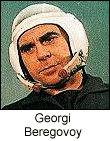 Soyuz-3
was launched from Baikonur at 0834 UT on 26 october 1968 carrying WW II
veteran Georgi Beregovoy as its sole occupant. Already on the very
first
orbits an unsuccessful attempt was made to dock with the unmanned
Soyuz-2
launched
on 25 October 1968. Beregovoy landed in Kazakhstan on 30 October 1968.
Not a very promising resumption of flights after the disaster with
Soyuz-1.
However, it was soon determined that the reason for the failure was
pilot
error! The Kettering group tracked Soyuz-3 extensively and Geoff Perry
put together a composite log (1) of all
receptions
from stations spread out over the globe. The figure below summarizes
the
observations.
Soyuz-3
was launched from Baikonur at 0834 UT on 26 october 1968 carrying WW II
veteran Georgi Beregovoy as its sole occupant. Already on the very
first
orbits an unsuccessful attempt was made to dock with the unmanned
Soyuz-2
launched
on 25 October 1968. Beregovoy landed in Kazakhstan on 30 October 1968.
Not a very promising resumption of flights after the disaster with
Soyuz-1.
However, it was soon determined that the reason for the failure was
pilot
error! The Kettering group tracked Soyuz-3 extensively and Geoff Perry
put together a composite log (1) of all
receptions
from stations spread out over the globe. The figure below summarizes
the
observations.
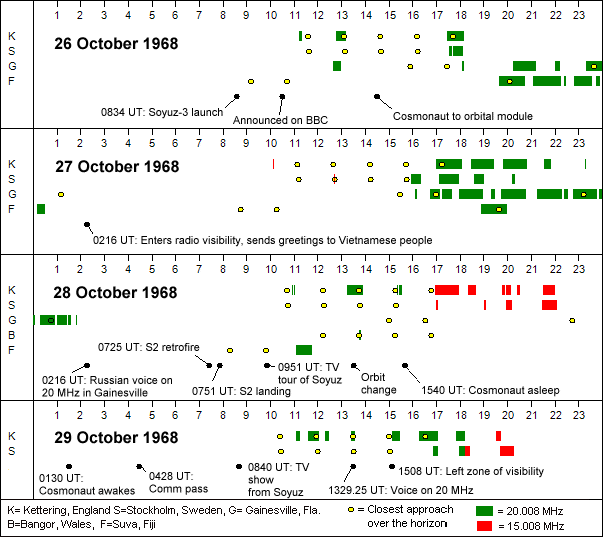
By the way, Soyuz-3 was
the
first manned spacecraft that I was able to track and the first
reception
i shown below.
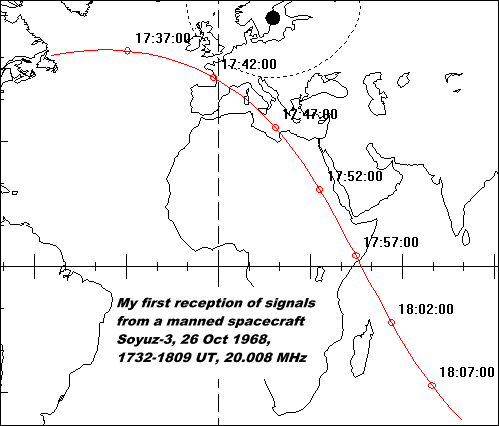
When I
found
the old tape I was glad to hear the telemetry signals from Soyuz-3
(listen
here
for a long segment of a signal on 20.008 MHz recorded just before
command-off
1814:26 UT on 29 October 1968. Click here
or on the picture of the telemetry below to listen to a short segment
of
the recording). I had not kept my own copies of these. Since this was
the
first manned spacecraft that I ever tracked the old recording had a
sentimental
value.
 However, I
thought
that maybe it was worth pursuing the thought that the "Zemlya ya
Sokol"
calls
had something to do with the Soyuz-3 flight. Therefore I distributed
copies
of the voice signals to fellow space trackers of the Kettering Group
that
may have picked up similar signals in the 1960's.
However, I
thought
that maybe it was worth pursuing the thought that the "Zemlya ya
Sokol"
calls
had something to do with the Soyuz-3 flight. Therefore I distributed
copies
of the voice signals to fellow space trackers of the Kettering Group
that
may have picked up similar signals in the 1960's.
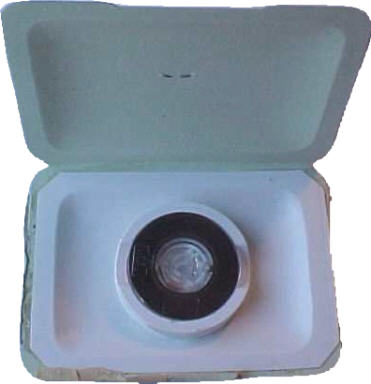 What
"Sokol" said
What
"Sokol" said
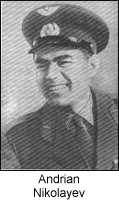 On
June 20, 2002 I received the following reply from veteran space tracker
Chris van den Berg about what was on the little tape (see picture on
the
right):
On
June 20, 2002 I received the following reply from veteran space tracker
Chris van den Berg about what was on the little tape (see picture on
the
right):
"...
Indeed
the voice communications by 'Sokol' (Nikolayev) took place during the
flight
of Beregovoy ('Argon'). During that flight I monitored 'Argon'
now
and then in traffic with a 'Vjezna' tracking station.
Sokol
opens the voice with the report that he had opened something. The
counterstation
is indeed 'Zemlya' (earth), but I had to concentrate very long to be
sure
for it could have been 'Zarya'. The counterstation could be
heard saying that he had a very bad reception. The voice of the
operator
on the counterstation sounds familiar for me. So I hope to find
somewhere
a recording with that voice!
In
my
opinion 'Sokol' was working as Capcom on a tracking ship or tracking
station.
I am always willing to re-evaluate old recordings of the good old
days in space flight!! ..."
An
intriguing glimpse into the past
A day or two
later
Chris wrote to me and other members of the Kettering Group:
"...
'Sokol'
was the call sign of Andrian Nikolayev, which he used during his flight
with Vostok-3, during the group flight with Vostok-4 (The call-sign of
cosmonaut Pavel Popovich in Vostok-4 was 'Berkut'). Nikolayev
also
used this call during his second flight in Soyuz-9 with Sevastyanov.
But,
there
have been occasions when he could be heard during communication tests
or
training. On several occasions I monitored him while calling on 20.008
MHz when there was no relation whatsoever with active space flight.
Other
calls during were used during some sessions with 'Zarya Odin'
(sounded
like Zaryadin) and VIKA's with numbers (tracking stations for
intercontinental
ballistic missile tests). Once I heard 'Sokol' speak with such a
station.
I also picked up a station 'Zemlya-4'.
Two
days
before the first flight of Leonov (Voskhod-2: 18 March 1965) with
Belyayev
there was a communication training during which 'Sokol' used
short
wave (20 MHz) during a contact with 'Berkut' (Popovich), there
was
also a station involved 'Pervyj' (nr. 1), and sometimes telemetry
signals!
Also such test sessions could be heard on 17 March 1965.
Often
cosmonauts and selected cosmonauts acted as capcoms on tracking ships
and
tracking stations.
I
discovered
the beginning of the flight of Bykovskiy (Vostok-5) on 20 MHz when a
Russian
controller ordered VIKA to leave this band immediately for 'there was
working
a cosmonaut' ..."
More
evidence about the extensive use of shortwaves during early Soviet
space
flight and missile tests.
At Jack M. Gallimore's now defunct web site there are intriguing accounts of how he
participated
in monitoring of Soviet space and missile tests from the Trabzon
monitoring
site in Turkey operated by the USAFSS's (USAF Air Force Security
Service)
6939th Radio Squadron Mobile unit. He served at Trabzon during eight
months
from October 1961 to May 1962. Jack describes how countdowns at the
Kapustin
Yar and Tyuratam launch sites were monitored on shortwaves and
how
telemetry from spacecraft and missiles was picked up on shortwaves and
VHF/UHF. He also describes how Soviet air defence radars reported their
plots of aircraft to a central point via shortwaves. In this way the
USAFSS
could plot the movements of Soviet interceptors and US spy planes in
real
time. This shows the heavy Soviet reliance on shortwaves which
obviously
was the case also for missile and space tests. Later, of course,
microwave
links largely replaced shortwaves to tie together tracking sites.
Checking
on another source
The messages
from
Chris van den Berg sounded very reassuring and my old recording from
1968
took on a new significance. To carry this inquiry one step further I
wrote
to Bart Hendrickx to find out if there is any evidence in General
Kamanin's
diary as to the whereabouts of flown cosmonauts during Soyuz-3 or other
early Soyuz flights: Did they go to tracking stations or did they go to
Baikonur?
Here is
what
Bart Hendrickx graciously replied:
"...
I've
checked Kamanin's diary entries for Soyuz-3. Nikolayev was at Baikonur
for the final launch preparations. On launch day Kamanin writes : 'Up
to
the T-15 minute point I and Andrian Nikolayev talked to Beregovoi via
the
radio and then we went to the bunker'. Shortly after the launch Kamanin
flew to Yevpatoriya to monitor the flight from there. The capcoms there
were Volynov and Shatalov (Beregovoi's back-ups). On 27 October
Kamanin
writes that Nikolayev and two generals (Shcheulov and Goreglyad) had
received
an order from the State Commission to fly to Karaganda to welcome
Beregovoi
after landing. So it seems to me that Nikolayev remained at the
cosmodrome
for about one day after launch and that if he did talk to Beregovoi in
orbit it must have been during that time ..."
Well, the
flight
flight started on 26 October and ended on 30 October 1968. The "Zemlya
ya Sokol" calls were only heard by me on 27 october 1968, so perhaps
Nikolayev
left for the recovery zone on 28 or 29 October. Other voice signals
(not
from "Argon") were heard on 29 and 30 October.
Conclusions
Adding
everything
together, I may have heard Andrian Nikolayev, but I fear that the only
way of finding out for sure is to ask the old cosmonaut himself! In any
case, the little tape reel provoked interesting comments from several
sources
and revealed hitherto unknown facts about early Soviet space flight
operations.
Also, I finally found my earliest Soyuz telemetry recording!
References
- "The
joint flight of Soyuz 2 and Soyuz 3, 1968-93A and 1968-94A. Cospar
Station
2289, Kettering." Internal Kettering Group memo written by Geoff
Perry
and dated 30 Decemberl 1968.

 Back
to Space Tracking Notes
Back
to Space Tracking Notes
 Soyuz-3
was launched from Baikonur at 0834 UT on 26 october 1968 carrying WW II
veteran Georgi Beregovoy as its sole occupant. Already on the very
first
orbits an unsuccessful attempt was made to dock with the unmanned
Soyuz-2
launched
on 25 October 1968. Beregovoy landed in Kazakhstan on 30 October 1968.
Not a very promising resumption of flights after the disaster with
Soyuz-1.
However, it was soon determined that the reason for the failure was
pilot
error! The Kettering group tracked Soyuz-3 extensively and Geoff Perry
put together a composite log (1) of all
receptions
from stations spread out over the globe. The figure below summarizes
the
observations.
Soyuz-3
was launched from Baikonur at 0834 UT on 26 october 1968 carrying WW II
veteran Georgi Beregovoy as its sole occupant. Already on the very
first
orbits an unsuccessful attempt was made to dock with the unmanned
Soyuz-2
launched
on 25 October 1968. Beregovoy landed in Kazakhstan on 30 October 1968.
Not a very promising resumption of flights after the disaster with
Soyuz-1.
However, it was soon determined that the reason for the failure was
pilot
error! The Kettering group tracked Soyuz-3 extensively and Geoff Perry
put together a composite log (1) of all
receptions
from stations spread out over the globe. The figure below summarizes
the
observations.
 While
visiting Kettering in the beginning of June 2002 Derek Slater, a
colleague
of Geoff
Perry's at The Kettering Grammar School and the radio expert of the
school's satellite tracking group, gave me a little tape reel that
I sent to Geoff Perry in 1968. From the postmark of the little box it
seemed
that it was mailed (see picture on the right) in November 1968.
While
visiting Kettering in the beginning of June 2002 Derek Slater, a
colleague
of Geoff
Perry's at The Kettering Grammar School and the radio expert of the
school's satellite tracking group, gave me a little tape reel that
I sent to Geoff Perry in 1968. From the postmark of the little box it
seemed
that it was mailed (see picture on the right) in November 1968.



 What
"Sokol" said
What
"Sokol" said On
June 20, 2002 I received the following reply from veteran space tracker
Chris van den Berg about what was on the little tape (see picture on
the
right):
On
June 20, 2002 I received the following reply from veteran space tracker
Chris van den Berg about what was on the little tape (see picture on
the
right):